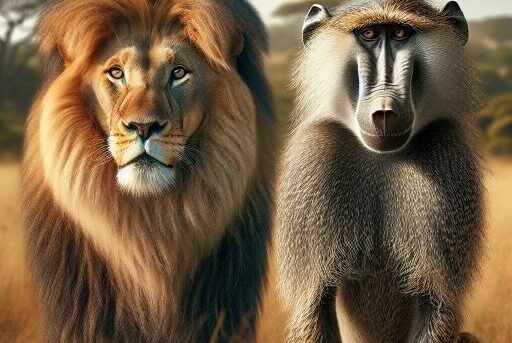Location and Habitat
The African lion, a majestic predator, thrives predominantly in the grasslands, savannas, and open woodlands of sub-Saharan Africa. These regal felines prefer territories that offer enough cover for hunting and proximity to water sources. Lions are social animals, often found in prides that provide a structured, cooperative environment for hunting and rearing young.
On the other hand, baboons are highly adaptable primates found in various habitats across Africa and into the Arabian Peninsula. They are commonly seen in savannas, forests, and even rocky hills. Baboons are known for their ability to exploit different environments, from arid semi-deserts to areas close to human settlements, where they sometimes become agricultural pests. Their social structure is organized into troops, which can consist of dozens to hundreds of members, helping them defend against predators and locate food efficiently.

African Lion vs. Baboon Comparison
| Animal | Size and Weight | Ability to Finish Opponent | Weaponry |
|---|---|---|---|
| African Lion | Length: 4.5-6.5 ft (head-body), Tail: 26.25-39.5 in, Weight: 265-420 lbs | High – powerful predator, can take down large prey | Sharp claws, strong jaws, powerful bite |
| Baboon | Length: 20-34 in, Weight: 33-82 lbs | Low – primarily defensive, not typically a predator | Sharp teeth, strong jaws |
Hunting and Skills
The African lion, a formidable predator, primarily hunts large ungulates such as zebras, wildebeests, and buffaloes, employing tactics that include stalking and then launching a powerful charge to take down their prey. Lions often hunt in groups, allowing them to strategically corner and overpower larger animals, and they are also known to take on other predators such as leopards and hyenas to steal their kills or eliminate competition.
Baboons, on the other hand, are omnivorous and have a diverse diet that includes fruits, seeds, and small animals such as birds, rodents, and even smaller monkeys. They are not hunters in the traditional sense but are adept at foraging and occasionally engaging in opportunistic hunting. When threatened, baboons rely on their strong social structure, retreating into large groups and using their formidable canine teeth to defend against predators. Their main defense mechanism includes loud vocalizations and threatening gestures to deter potential threats.
African Lion vs. Baboon Who Would Win?
The African lion charges at the baboon, using its superior size and strength. The baboon attempts to evade and retaliate with bites and scratches. However, the lion’s powerful build and predatory skills overpower the baboon. The lion delivers a fatal bite to the baboon. Winner: African Lion with a 95% chance of winning.
Despite the clear advantage lions hold in a fight, these species often share the same territory. Baboons, with their keen eyesight, can act as sentinels for lions, alerting them to approaching danger. In return, the presence of lions can deter other predators that might target baboons. This unlikely partnership demonstrates a fascinating example of a commensal relationship within the African savanna ecosystem.




